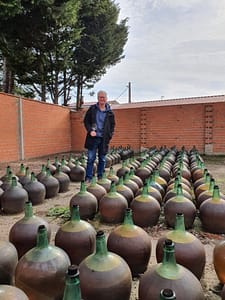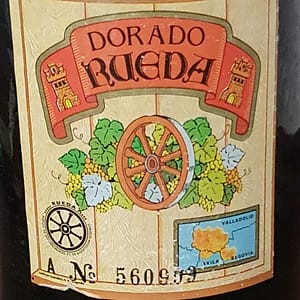I come from the west where I have photographed the monument in memory of the Battle of Toro, which laid the foundation for a unified Spain. Here in and around the villages of La Seca and Rueda, I will visit some of the producers who are now involved in a restoration of the historic dorado wine. This was a popular drink at the courts over five hundred years ago, when the aforementioned battle took place.
How much this wine is inspired by the more famous in Jerez is hard to say, as Spain after the fall of the empire almost had a collective memory loss of 150 years, and very little was written. But several conditions coincide, from the grape variety palomino fino (here together with the local verdejo), oxidative storage in oak barrels (as in the main category oloroso), the use of “botas” (600 liter oak barrels) and large glass containers called “damajuanas” . Wait a minute! Many people would probably call them demijohns, as in English.
My good musician friend Ivan, who works for the producer Menade, lectures: -The word probably comes from the French dame-jeanne and refers to Queen Joanna I of Naples. Legend has it that during a storm she sought refuge in the workshop of a master glassblower, and she became interested in the art of blowing glass. She wanted to try to make her own bottle, blew with great force and got a ten liter bottle. This bottle and its successors were called dame-jeanne, and the look was soon linked to a lady’s round shapes. The art and designation triumphed, and when it came to Spain in the 15th century, it was associated with Juana, who was the daughter of Queen Isabel II and one of the parties in the Castilian War of Succession, where the battle mentioned in the introduction was included. We continue with our introduction, and we will meet Ivan again in article number three.
DO Rueda currently has its own category for dorado in its legislation. It states that the wine must be made of palomino fino and / or verdejo and have at least 15% alcohol. It must have undergone oxidative storage and must have been in oak barrels for at least two years before it is launched. Their general characteristics are a golden color, aroma of dried and roasted fruit, oxidative properties, and it should be powerful, glyceric and complex in the mouth. Some may also have an aroma of vanilla. Unlike sherry, most also have the verdjo’s flattering, fruity (sometimes sweet) nose and slightly bitter aftertaste. There is also a category for biological storage (under a layer of the yeast «flor») called pálido.
In the production of dorado with DO, the wine must contain at least 40% verdejo. When the fermentation is complete, alcohol is usually added so that it is at least fifteen degrees. Most people believe that this is also necessary for the wine to withstand the further process. The wine is usually poured into the damajuans, which usually contain 16 liters. The wine is placed outdoors for more than a year, so that it can be exposed to sun and temperature fluctuations, which gives it a golden colour and its characteristic aromas. In the past, it was common to spend more time in something more reminiscent of a solera system. After storage in glass, the whole thing is completed with a stay in an oak barrel.
Félix Lorenzo Cachazo
At Félix Lorenzo Cachazo, I am welcomed by brother and sister Eduardo and Ángela Cachazo, who are 6th generation. Eduardo takes care of public relations, while Ángela is an oenologist. The family’s Carrasviñas was the first Dorado wine bottled in 1946, and their father Félix was one of the eight founders of DO Rueda in 1980.
Cachazo uses the grape varieties verdejo and palomino fino. The grape mixture is 65% verdejo, which grows some distance away, in the village of Alcazarén, where there is sandy soil and pre-phylloxera vines. The rest is palomino, which is grown around the bodega in Pozaldez. -We work with small growers from the area. They are a treasure to us; we are in debt to the area, says Eduardo.
Harvest is usually late, in late October. The grapes are harvested at potentially 15% alcohol. The grapes are vinified separately, stalked and gently pressed. The must is then fermented in a stainless steel tank. After the alcohol fermentation follows a racking, and wine from the two varieties is mixed. Then it is temporarily filled in 16-liter damajuanas. These are left in the patio for 18 months, where the wine develops “flor” in the spring, in what is called biological fermentation. During this time, it also undergoes an oxidative storage that gives the wine a golden color. Then it stays for two years in 2-3 year old barrels, French and American.
Cachazo makes 2,500 bottles of dorado annually. -It is allowed to mix vintages, but we make vintage wines, says Eduardo. -We use a cultivated yeast strain from the local verdejo.
We tasted their Dorado 2017 together with oenologist Ángela: Golden, pure and light color. Aroma of quince jam, hazelnut, dried fruit and vanilla. Full-bodied in the mouth with nuts and spices, a toasted tone and a hint of bitterness in the aftertaste (from verdejo). A textbook example (or what you would think of as typical, since very little is written about these wines). On the whole, this may be the closest you get to the classic wines, at least after the norm became a short time in the patio rather than a long time in the solera.
-In the past, wines were not infrequently at 17-18% alcohol. Today we do not add alcohol; it was our grandfather who stopped this and brought the wines down to 15% as today, the siblings say.
Eduardo is interested in history and can complement our historical introduction with an interesting etymological outline: Pozaldez has less than 500 inhabitants and two churches. The name was Pozoldes (meaning wells) in the 13th century, changed to Pozal de las Dos Iglesias (the pool of the two churches) in 1587 and then changed its name to Pozal de Hez. Here, hez refers to the sediments that remain on the wine barrel after fermentation. The church of San Boal, where we stand, has Mozarabic features. It was also the Mozarabs (Berbers under the new Christian rule) who brought the grape verdejo to Spain from North Africa. Palomino, the grape that dominates sherry production, also certainly has a history of at least 500 years in our region.








